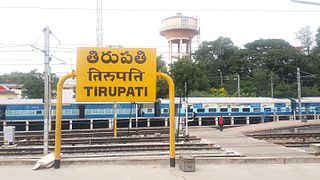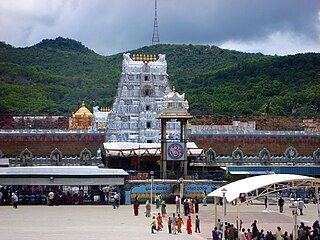Related Research Articles

Tirumala Tirupati Devasthanams (TTD) is an independent government trust in India which manages various temples, including the Tirumala Venkateswara Temple in Andhra Pradesh. The trust oversees the operations and finances of the richest and the most visited religious center in the world. It is also involved in various social, religious, literary and educational activities. TTD is headquartered at Tirupati and employs about 16,000 people. Srivani trust was set up by TTD in 2019 to promote Sanātana Dharma by constructing temples in SC-ST-BC habitations, renovating ancient temples, and providing funds under Dhup-Deepa-Naivedyam Scheme to those temples facing financial difficulty. By January 2023, TTD has taken up construction of 2,068 temples in Andhra Pradesh, Telangana, Pondicherry and Karnataka. TTD's main source of income is Srivani darshan tickets which were earning it Rs 1 crore per day in January 2024.

Chittoor is a city and district headquarters in Chittoor district of the Indian state of Andhra Pradesh. It is also the mandal and divisional headquarters of Chittoor mandal and Chittoor revenue division respectively. The city has a population of 153,756 and that of the agglomeration is 175,647.

Chandragiri is a suburb and neighbourhood of Tirupati and located in Tirupati district of the Indian state of Andhra Pradesh. It is a part of Tirupati urban agglomeration and a major growing residential area in Tirupati It is the mandal headquarters of Chandragiri mandal in Tirupati revenue division. It also falls in the jurisdictional limit of Tirupati Urban Development Authority. Chandragiri is the southwestern entrance of Tirupati for vehicles coming from Bangalore, Kerala and Tamil Nadu. Kalyana Venkateswara Temple, Srinivasamangapuram is located next to Chandragiri through which well-laid stone footpaths called Srivari Mettu are available to reach Tirumala on foot.

Tirupati is a city in the Indian state of Andhra Pradesh. It is the administrative headquarters of the Tirupati district. The city is home to the important Hindu shrine of Tirumala Venkateshwara Temple and other historic temples. It is located at a distance of 150 km from Chennai, 250 km from Bangalore, 406 km from Amaravati. It is one of the eight Svayam vyakta kshetras dedicated to Vishnu. Tirupati is a municipal corporation and the headquarters of Tirupati (urban) mandal, Tirupati (rural) mandal, and the Tirupati revenue division.

Chittoor district is one of the eight districts in the Rayalaseema region of the Indian state of Andhra Pradesh. It had a population of 18,72,951 at the 2011 census of India. It is a major market centre for mangoes, grains, sugarcane, and peanuts. The district headquarters is at Chittoor City.

Muhammad Yusuf Khan was a commandant of the British East India Company's Madras Army. He was born in a Tamil Vellalar clan family in a village called Keelapanaiyur in British India, what is now in Mudukulathur Taluk, Ramanathapuram District of Tamil Nadu, India. He converted to Islam and was named Muhammad Yusuf Khan. He was popularly known as Khan Sahib when he became the ruler of Madurai. He became a warrior in the Arcot troops, and later a commandant for the British East India Company troops. The British and the Arcot Nawab employed him to suppress the Polygar uprising in South India. Later he was entrusted to administer the Madurai country when the Madurai Nayak rule ended.

North Arcot was a former district in Madras Presidency, acquired by the annexation of the Arcot State in 1855 when its Nawab died without issue. It had Chittoor as its headquarters. On 1 April 1911, the Chittoor district was separated from North Arcot. The remaining district, with Vellore as its headquarters, passed intact into the Madras State of independent India. On 30 September 1989 the district was split into Tiruvannamalai-Sambuvarayar district and North Arcot Ambedkar district. It contained the present day districts of Tiruvannamalai, Vellore, Chittoor, Tirupati, Tirupattur and Ranipet.

The Carnatic Sultanate was a kingdom in South India between about 1690 and 1855, and was under the legal purview of the Nizam of Hyderabad, until their demise. They initially had their capital at Arcot in the present-day Indian state of Tamil Nadu. Their rule is an important period in the history of the Carnatic and Coromandel Coast regions, in which the Mughal Empire gave way to the rising influence of the Maratha Empire, and later the emergence of the British Raj.

The Sri Venkateswara Swami Temple is a Hindu temple situated in the hills of Tirumala at Tirupati in Tirupati district of Andhra Pradesh, India. The temple is dedicated to Venkateswara, a form of Vishnu, who is believed to have appeared on the earth to save mankind from trials and troubles of Kali Yuga. Hence the place is also known by the name Kaliyuga Vaikuntha and the deity here is referred to as Kaliyuga Prathyaksha Daivam. The temple is also known by other names like Tirumala Temple, Tirupati Temple and Tirupati Balaji Temple. Venkateswara is known by many other names: Balaji, Govinda, and Srinivasa. The temple is run by Tirumala Tirupati Devasthanams (TTD), which is under control of Andhra Pradesh Government. The head of TTD is appointed by Andhra Pradesh Government.

Pakala is a town in Tirupati district of the Indian state of Andhra Pradesh. It is the mandal headquarters of Pakala mandal. It comes under Tirupati revenue division.

Muhammad Ali Khan Wallajah, or Muhammed Ali, Wallajah, was the Nawab of the Carnatic from 1749 until his death in 1795. He declared himself Nawab in 1749. This position was disputed between Wallajah and Chanda Sahib. In 1752, after several clashes, Chanda Sahib's forces and his French allies were expelled from Arcot, officially declaring Wallajah as Nawab on 26 August 1765. His reign was recognised by Mughal emperor Shah Alam II.

Chanda Sahib was a subject of the Carnatic Sultanate between 1749 and 1752. He was the son-in-law of the Nawab of Carnatic Dost Ali Khan, under whom he was a Dewan. An ally of the French, he was initially supported by Joseph François Dupleix during the Carnatic Wars. He annexed the Madurai Nayaks and was declared Nawab, bringing Tanjore and Tinnevelly into the dominions of the Mughal Empire.
Tirupati Rural mandal is one of the 34 mandals in Tirupati district of Andhra Pradesh in India. It is under the administration of Tirupati revenue division and the headquarters are located at Tirupati.

Konetirayala Swamy Temple is a Hindu temple of Lord Venkateswara in the town of Keelapatla, Palamaner, Chittoor District, Andhra Pradesh, India.

The siege of Arcot took place at Arcot, India between forces of the British East India Company led by Robert Clive allied with Muhammad Ali Khan Wallajah and forces of Nawab of the Carnatic, Chanda Sahib, allied with the French East India Company. It was part of the Second Carnatic War.

Chepauk Palace was the official residence of the Nawab of Arcot from 1768 to 1855. It is situated in the neighbourhood of Chepauk in Chennai, India and is constructed in the Indo-Saracenic style of architecture.

Tirupati Main railway station is a railway station located in the Indian state of Andhra Pradesh. It serves Tirupati and experiences a regular flow of tourists visiting the Tirumala Venkateswara Temple in the Tirupati district. It is an environmentally friendly station, and has been awarded a Gold rating by the Indian Green Building Council. There are several railway stations that fall within the city limits of Tirupati, namely Tiruchanur, Renigunta Junction, Tirupati West Halt, and Chandragiri railway station.

Triplicane Big Mosque is a mosque located in Triplicane High Road, Triplicane in Chennai, the capital of the South Indian state of Tamil Nadu. Constructed in the Mughal architectural style, the mosque was built in 1795 by the family of Muhammad Ali Khan Wallajah, the Nawab of Arcot during 1765. It has a large prayer hall, a tank and a large ground in front. The entire structure is constructed with granite without the use of iron or wood.
Venkateswara Temple is an important Vaishnavite temple situated in the hill town of Tirumala in Tirupati district of Andhra Pradesh, built by a Tamil king Tondaiman and later expanded and renovated under the Chola and Vijayanagara Empire. The Temple is dedicated to Lord Venkateswara, an incarnation of Vishnu, who is believed to have appeared here to save mankind from the trials and troubles of Kali Yuga. The temple is situated at a height of 853 metres on Tirumala Hills which are part of Seshachalam Hills and is constructed in South Indian Tamil Architectural Style.

Tirupati district is one of the eight districts of Rayalaseema region in the Indian state of Andhra Pradesh. The district headquarters is located at Tirupati city. This district is known for its numerous historic temples, including the Hindu shrine of Tirumala Venkateswara Temple and Sri Kalahasteeswara temple. The district is also home to Satish Dhawan Space Centre, a rocket launch centre located in Sriharikota. The river Swarnamukhi flows through Tirupati, Srikalahasti, Naidupeta, Vakadu and join into the Bay of Bengal.
References
- ↑ Well-defined rules contained in the Bruce Code drawn up in 1821 on the basis of previous usages and customs and did not interfere in its day-to-day affairs [usurped]
- ↑ Valuable work done by britishers in systematising the administration of the Tirupati Temple
- ↑ "After the fall of the Hindu empires, the Tirumala and Tirupati temples came under the sway of the Nawabs of Arcot, and with the advent of the English, the management passed into the hands of the East India Company in 1801". Archived from the original on 12 July 2011. Retrieved 13 February 2011.
- ↑ History of the Hindu religious endowments in Andhra Pradesh By Koutha Nirmala Kumari - Page 123 - In the early years of Nineteenth Century, temple of Tirumala was taken over by East India Company from Nawab of Arcot
- ↑ - Page 2 - Bruce's Code Archived 21 July 2011 at the Wayback Machine
- ↑ There has always been lots of money floating around Balaji, tempting the East India Company in 1748, nine years before the battle of Plassey, to devise insidious ways of wresting control of the unending revenue source. A few years later, it finally browbeat the Nawab of Arcot into giving the Company total and direct control of the temple's administration. This continued till 1843
- ↑ "The temple controlled a lot of land and the East India Company was quite open about its greed, as were the French and the Mysore kings," said Varadachary, a Tirupati historian.The East India Company made around 25,000 pounds every year from the temple in the mid-1750s.
- ↑ History of the Hindu religious endowments in Andhra Pradesh - Page 124 - Court of Directors strongly resented the participation of officers in administration and management of Hindu Temple during the reign of Queen Victoria
